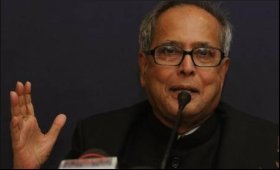|

|
Mukherjee has room to budget for lower fiscal deficit
|
|

|
|
| Top Stories |
 |
|
|
|
Arvind Padmanabhan | 22 Feb, 2010
Having opened the purse strings to weather the ills of global slowdown the past two years, Finance Minister Pranab Mukherjee appears set to re-start the process of fiscal consolidation in the national budget for 2010-11 to be presented Friday with the twin objective of pushing inclusive growth and containing prices.
With fiscal deficit estimated at 6.8 percent of gross domestic product (GDP) for the current fiscal, Mukherjee's fifth regular budget in his long political career will have little room to manoeuvre as far as any meaningful hike in the outlays for various welfare programmes are concerned.
Yet, the robust revival of industrial sector that has made policy-makers and pundits revise India's growth prospect for this fiscal to 7.5 percent from around 6.5 percent earlier, coupled with the return of double-digit expansion in the country's merchandise exports, will give him some much-needed elbow room to lower expenditure.
Significantly, the government already has major relief on account of two issues. The Rs.60,000-crore ($12 billion) farm loan waiver programme has concluded. And the salary arrears have already been paid to government employees on account of the hike proposed by the pay commission.
Little wonder the Prime Minister's Economic Advisory Council, chaired by former Reserve Bank of India Governor C. Rangarajan, has said in its latest review of the economy that these two measures alone will bring expenditures down significantly.
"This should be feasible. Overall, it should be possible to reduce the expenditure-to-GDP ratio by about one percentage point without too much difficulty," the council said in the report presented to Prime Minister Manmohan Singh a couple of days ago.
For taxpayers, there is however little hope in the upcoming budget for any major rebate in personal income tax rates as collections on this count actually declined 0.41 percent in the first three quarters of this fiscal.
Even the overall direct tax collections has grown just 8.5 percent during the nine-month period under review, exerting equal pressure not to tinker with the corporate tax rate. If at all, there is only the temptation to restore the tax surcharge.
So the bulk of the additional revenue mop-up exercise may come from a hike in excise duties, which, in any case, is expected as India starts exiting the Rs.186,000-crore ($37-billion), three-tranche fiscal stimuli since December 2008 and prepares for a shift to a pan-India goods and services tax.
Expansion of the service tax net is another option. Accordingly, some services that had escaped the service tax net in the past are likely to be brought under this regime, including those rendered by doctors, lawyers, on rail travel and in freight. This is expected to bring down the deficit by another 50 basis points.
These apart, the auction of frequency for telecom operators and divestment of equity in state-run companies -- for which a host of enterprises have already been identified -- is expected to open two more lucrative avenues for additional revenues.
"We expect to see a partial withdrawal of tax concessions, both excise duty and service taxes, and the possibility of re-introduction of surcharges," said Rohini Malkani, a senior economist with Citi Group India, a think tank.
Thus, the major avenues for fiscal consolidation are expected to be:
- Better tax collections due to higher growth;
- Expansion of the service tax net;
- Divestment of stake in state-run enterprises;
- Auction of spectrum for third generation telephony; and
- Freeze on subsidies such as those on fertiliser;
All these taken together, it is possible to easily bring down the deficit by 200 basis points to a much more manageable 4.8 percent of GDP, which will be higher than the level of 2.7 percent in 2007-08 but still lower than the six percent for 2008-09. How much of it will be used to step up funds for welfare programmes is a moot point.
The government has exhibited courage in taking some harsh decisions by hiking the prices of urea by 10 percent last week and unveiling a new fertiliser subsidy scheme that will freeze such doles in the future, despite objections from key allies.
It is, therefore, clear that Pranab Mukherjee's fifth regular budget as finance minister and the seventh for the two successive terms of the United Progressive Alliance (UPA) government cannot be overtly populist -- though inclusive growth will remain the central focus.
The surprise element, if any, will be in the content of his budget speech on the pro-poor focus of his government, bridging the infrastructure deficit, restoring the industrial sector's confidence, continuity of economic reforms and nursing India back to a high, sustainable growth path, even if he chooses not to lose sleep over market movements.
* Arvind Padmanabhan is Executive Editor - Business with IANS. He can be reached at arvind.p@ians.in.
* The views expressed by the author in this feature are entirely his/her own and do not necessarily reflect the views of SME Times.
|
|
|
| |
|
|
|
|
|
|
|
|
|
|
|
|
|
|
| |
| Customs Exchange Rates |
| Currency |
Import |
Export |
US Dollar
|
66.20
|
64.50 |
UK Pound
|
87.50
|
84.65 |
Euro
|
78.25
|
75.65 |
| Japanese
Yen |
58.85 |
56.85 |
| As on 13 Aug, 2022 |
|
|
| Daily Poll |
 |
 |
| PM Modi's recent US visit to redefine India-US bilateral relations |
|
|
|
|
|
| Commented Stories |
 |
|
|
|
|
|
| |
|